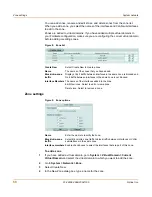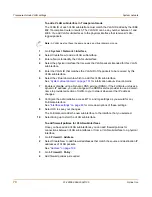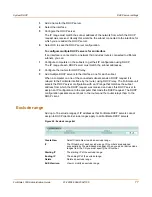
64
01-28006-0068-20041105
Fortinet Inc.
FortiGate units and VLANs
System network
FortiGate units and VLANs
In a typical VLAN configuration, 802.1Q-compliant VLAN layer-2 switches or layer-3
routers or firewalls add VLAN tags to packets. Packets passing between devices in
the same VLAN can be handled by layer 2 switches. Packets passing between
devices in different VLANs must be handled by a layer 3 device such as router,
firewall, or layer 3 switch.
Using VLANs, a single FortiGate unit can provide security services and control
connections between multiple security domains. Traffic from each security domain is
given a different VLAN ID. The FortiGate unit can recognize VLAN IDs and apply
security policies to secure network and IPSec VPN traffic between security domains.
The FortiGate unit can also apply authentication, protection profiles, and other firewall
policy features for network and VPN traffic that is allowed to pass between security
domains.
VLANs in NAT/Route mode
Operating in NAT/Route mode, the FortiGate unit functions as a layer 3 device to
control the flow of packets between VLANs. The FortiGate unit can also remove VLAN
tags from incoming VLAN packets and forward untagged packets to other networks,
such as the Internet.
In NAT/Route mode, the FortiGate units support VLANs for constructing VLAN trunks
between an IEEE 802.1Q-compliant switch (or router) and the FortiGate unit. Normally
the FortiGate unit internal interface connects to a VLAN trunk on an internal switch,
and the external interface connects to an upstream Internet router untagged. The
FortiGate unit can then apply different policies for traffic on each VLAN that connects
to the internal interface.
In this configuration, you add VLAN subinterfaces to the FortiGate internal interface
that have VLAN IDs that match the VLAN IDs of packets in the VLAN trunk. The
FortiGate unit directs packets with VLAN IDs, to subinterfaces with matching VLAN
IDs.
You can also define VLAN subinterfaces on all FortiGate interfaces. The FortiGate
unit can add VLAN tags to packets leaving a VLAN subinterface or remove VLAN tags
from incoming packets and add a different VLAN tags to outgoing packets.
Rules for VLAN IDs
In NAT/Route mode, two VLAN subinterfaces added to the same physical interface
cannot have the same VLAN ID. However, you can add two or more VLAN
subinterfaces with the same VLAN IDs to different physical interfaces. There is no
internal connection or link between two VLAN subinterfaces with same VLAN ID. Their
relationship is the same as the relationship between any two FortiGate network
interfaces.
Rules for VLAN IP addresses
IP addresses of all FortiGate interfaces cannot overlap. That is, the IP addresses of all
interfaces must be on different subnets. This rule applies to both physical interfaces
and to VLAN subinterfaces.
Summary of Contents for FortiGate FortiGate-100A
Page 24: ...24 01 28006 0068 20041105 Fortinet Inc FortiLog documentation Introduction...
Page 72: ...72 01 28006 0068 20041105 Fortinet Inc Transparent mode VLAN settings System network...
Page 80: ...80 01 28006 0068 20041105 Fortinet Inc DHCP IP MAC binding settings System DHCP...
Page 114: ...114 01 28006 0068 20041105 Fortinet Inc Access profile options System administration...
Page 232: ...232 01 28006 0068 20041105 Fortinet Inc CLI configuration Firewall...
Page 244: ...244 01 28006 0068 20041105 Fortinet Inc peergrp Users and authentication...
Page 320: ...320 01 28006 0068 20041105 Fortinet Inc service smtp Antivirus...
Page 366: ...366 01 28006 0068 20041105 Fortinet Inc syslogd setting Log Report...
Page 380: ...380 01 28006 0068 20041105 Fortinet Inc Glossary...
Page 388: ...388 01 28006 0068 20041105 Fortinet Inc Index...











































